ASRock 890FX Deluxe: Comprehensive Motherboard Review & Investigation of Thuban Performance Scaling
by Rajinder Gill on August 31, 2010 7:00 AM EST- Posted in
- ASRock
- AMD
- Motherboards
- 890FX
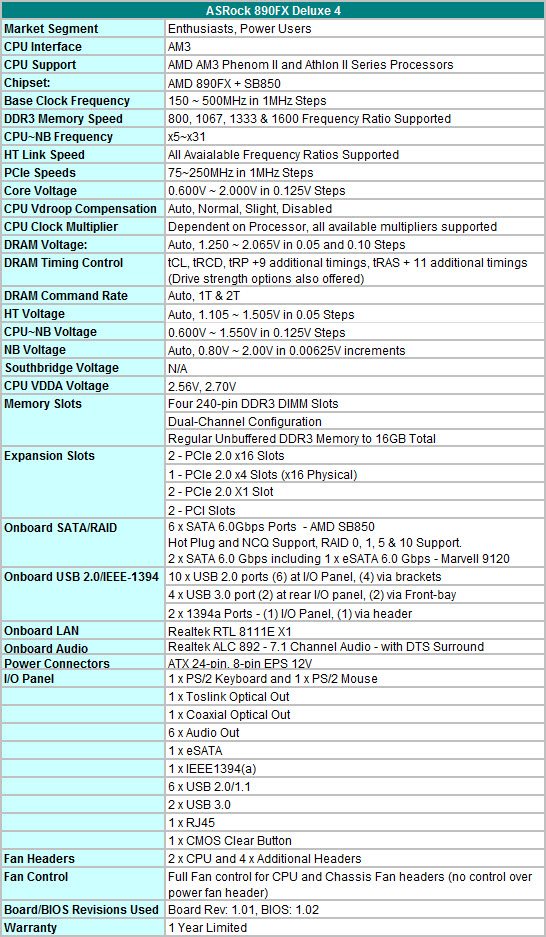
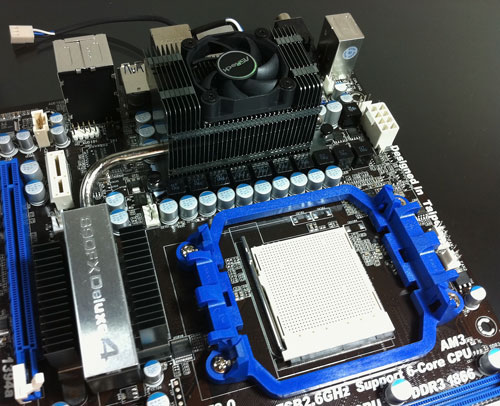
Back to the 890FX Deluxe 4, we start with the CPU socket area and immediately notice the tall mosfet heatsink. The heatsink is 2” tall, and the plate with number “4” etched on it can be taken out for optional fan (50x10mm) installation. We are usually not fans of fans of this size (get that?), because of their tendency to generate noise and to die young. However, the ASRock supplied fan wasn’t noticeably loud, even at its maximum 5,000RPM. Moreover, we found it to be doing an excellent job at keeping the heatsinks cool. Add to that the board has many available fan headers that can be individually controlled; we don’t see this optional fan as a minus. To the contrary, it may even be a necessity should you overclock your CPU and your CPU cooler is one of those tall tower-style heatsinks, because those heatsinks often do a poor job at cooling the CPU socket area.
Even though we didn’t have problem installing popular cooling solutions like Scythe Mugen 2 and Cooler Master Hyper 212+, as well as Corsair H50 watercooling kit, push-pull configuration using two fans was not possible due to the height of MOSFET heatsink. Also, many of tower-style CPU coolers will interfere with tall, fancy memory sticks. This isn’t an issue limited to the Deluxe 4, but rather a common one on AM2+/AM3 sockets due to their close proximity to DIMM sockets. We suggest you plan ahead so that you do not run into an unexpected surprise.
Around the CPU socket we see total six on-board fan headers: Two for 4-pin PWM fans, four for 3-pin fans. Out of the four 3-pin headers, three of them can be controlled in BIOS and/or in Windows. The one header that can’t be controlled is for the power supply fan that nobody uses these days, but it still provides RPM monitoring for any fan plugged in Windows via OC Tuner utility. For the other 3-pin headers, you can set from “level 1” to “level 10” strength, level 1 being about 60~70% of maximum RPM depending on the fans and level 10 being 100%.
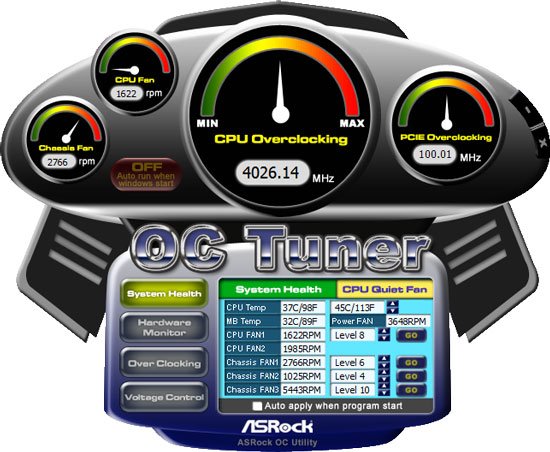
It goes without saying that we are glad to see this amount of fan control provided by the Deluxe 4. One might nitpick on the fact that not all fan headers are aware of ambient temperatures and acting on their own, and that would be a serious miscalculation oblivious to the reality, in which majority of motherboards on the market today give users nearly non-existent fan control except for the CPU.
However, it’s for this excellent fan control ASRock bestows on the Deluxe 4 we are all the more puzzled why ASRock didn’t locate some of the headers on other areas of the board. They’re far away from a case’s front and side fans, and once a CPU HSF and a video card are installed it becomes nearly impossible to reach them without needle-nose pliers. Also a word of caution: Upon installation of the OC Tuner utility, it will set up an extra power plan in the Windows’ Control Panel. We advise you delete this plan immediately because it doesn’t do anything special but disable S3 sleep and PCI-Express power management. Stick to Window’s built-in Power Plans or make your own to suit your needs.

Moving on, we see the DIMM sockets are correctly color-coded for dual-channel operation. There is plenty of clearance between the DIMM sockets and the first PEG slot, making it easy to swap video cards or memory sticks should the need arise. Next to the right of the DIMM sockets located two USB 2.0 headers and a Firewire header. Though this is not the most common spot for these, it should not pose trouble for a typical mid/full-tower case. In charge of Firewire is the VIA VT6330, which doubles its duty as the board’s PATA controller. The PATA connector is located right below the Firewire header, facing outward.
Down below, we see six SATA 6.0 Gbps connectors courtesy of SB850. The connectors are angled by 90 degree so that large video cards do not block their entrance. These connectors, we’re happy to report, are correctly numbered on the board’s PCB, manual, and in the BIOS. This may sound trivial but it is one of those things that board makers can’t seem to get right for whatever reason. If you have ever had to go through the process of trial and error to determine which port is port No. 1 and which is No. 6 (or anything in between) to setup a RAID array or a hot-swap bay, you’ll know what we’re talking about. On the Deluxe 4, port No. 1 is port No. 1 in the BIOS, in the manual, and on the board’s PCB whether the storage subsystem is configured as plain IDE, AHCI, or RAID mode.
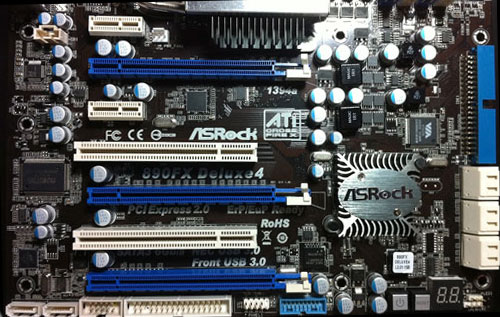
We now turn to the board’s expansion slots. There are total five PCIe slots and two PCI slots. All PCIe slots are rooted in 890FX north bridge and are at fixed bandwidth. The first PCIe x1 slot at the top is half-way open until it is blocked by the north bridge heatsink, so it can only accept half-length add-in cards, e.g. a wireless adapter card. From there down, the board has an additional PCIe x 1 slot in white and three full-length PEG slots in blue. The top two PEG slots are both physically and electrically x16, and the bottom PEG (also blue) is physically x16 and electrically x4. The white PCI slots are sandwiching the last PEG, but there is an access to at least one of these even when multiple double-width graphics cards are installed. Installing a double-width video card in the last PEG, however, will block the access to the board’s auxiliary SATA ports, the front-panel USB 3.0 connector, (gasp) the floppy connector and the COM port.

The board’s USB 3.0 ports are provided by ubiquitous NEC 720200F chipsets, two of them, each serving up two ports for total of four. The board’s installation CD came with the latest drivers (v.10190), and we experienced no compatibility issue with HDD docks from Vantec and ICY DOCK we purchased off the shelf.
The two auxiliary SATA ports on the bottom-left corner are controlled by Marvell 9120 which support AHCI (but no RAID), and frankly it’s incomprehensible to us why they have to be there. Suffice to say the ASRock provided SATA cables were not long enough to reach any of the hard drives in our HAF 932 case. Smaller cases might fare better, but your choices will be limited by the physical distance. It would have been nice if ASRock positioned those ports more sensibly on the board or bundled longer SATA cables.
The usual suspects (hint: you might have one in your board, too) show up to fill up the rest of the on-board duties: Realtek 8111E for gigabit network and Realtek ALC892 for 7.1 HD audio. The board is also equipped with an on-board debug LED, on-board power switch and on-board reset switch that come in handy when overclocking.

The rear I/O panel selection is good, and we only caution that the eSATA port shares the Marvell controller with the two on-board auxiliary SATA ports. If you attempt to use the eSATA while both of Marvell ports are internally used, you will be greeted with a BSOD.
DPC latency was excellent on the Deluxe 4. The shot below was taken while Prime95 was running in the background and a virtual machine streaming 1080p video to a PlayStation 3. The small spike occurred when we launched OC Tuner utility and it is a common occurrence we see on motherboards when a low-level hardware monitoring application is launched.
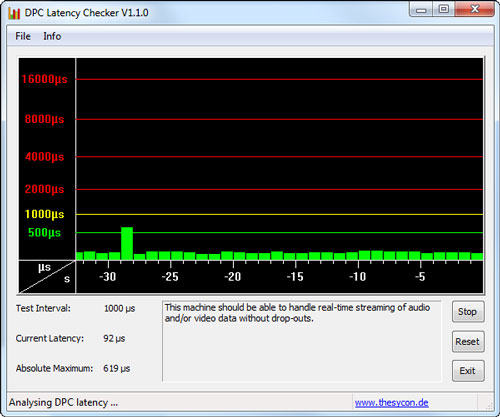










42 Comments
View All Comments
jonup - Tuesday, August 31, 2010 - link
Very impressed to see this approach to your testing. I hete when reading an MB reveiw and reach the benchmark section. Same chipsets tend to perform the same. A guess this would be an one-off since in the next review it will be redundant.vol7ron - Tuesday, August 31, 2010 - link
agreed, nice review.Finally - Tuesday, August 31, 2010 - link
I must say that this review was nice to have, I'm much more interested in the 870 Chipset.It's almost identical, except the support of Crossfire, which I have no use for.
RequiemsAllure - Wednesday, September 1, 2010 - link
ahh, but on the ASRock 870 extreme 3 Crossfire is supported.SpaceRanger - Tuesday, August 31, 2010 - link
In the article:USB 3.0 Performance
We use Acronis TrueImage Home (v. 10) to make a backup of our installation drive to an external SATA 3.0 Gbps drive via USB 3.0 and compare it with USB 2.0 and SATA 3.0 Gbps transfers. The total data backed up is approximately 20 GB. We could not complete the backup on the 890GTD Pro/USB3 in a consistent manner.
My Question:
Why were you not able to complete the backup on the 890GTD Pro/USB3? At the conclusion you state :
Is it worth $180 when ASUS 890GTD Pro/USB3 is $30 less? We think the difference largely comes down to the board’s selection of components.
I would call not being able to do a simple backup with the 890GTD enough of a showstopper to not even consider the board. Am I missing something here?
semo - Tuesday, August 31, 2010 - link
I'm also wondering about the SATA3 performance. An issue was identified here on AT with the new 8xx chipset earlier which slowed down SSDs considerably compared to ICH10 controllers. Has this been fixed yet?Kane Y. Jeong - Tuesday, August 31, 2010 - link
Hi,Please check Raja's ASUS M4A89GTD Pro/USB3 review here.
http://www.anandtech.com/show/2959
We purchased another retail M4A89GTD Pro/USB3 off the shelf, and still ran into inconsistent USB 3.0 performance. Sometimes the drives lost connections, and Acronis reported error in the middle of backup process. Success ratio to complete the backup was about 30~40%. An alternative would be to purchase M4A89GTD Pro (not Pro/USB3) for $10 less and go with an add-in card. We did not experience this issue on ASRock 890FX Deluxe 4.
SpaceRanger - Tuesday, August 31, 2010 - link
Thank you for the response. So you're advising getting the Pro (not Pro/USB3) instead of the 890FX? Cause Raja's findings would be enough for me to not want to get it.nbjknk - Thursday, November 25, 2010 - link
Dear customers, thank you for your support of our company.
Here, there's good news to tell you: The company recently
launched a number of new fashion items! ! Fashionable
and welcome everyone to come buy. If necessary, please$$$$$$$$$$__$$$_$$$$$$$$$$$
http://www.vipshops.org
$$_____$$$_$$$_________$$$
$$$_____$$$_$$$______ $$$
$$$ ____$$$_ $$$_____ $$$
$$$$$$$$$$__$$$____$$$
$$$_____$$$_$$$___$$$
$$$_____$$$_$$$__$$$
$$$$$$$$$$$_$$$_$$$
$$$$$$$$$$__$$$_$$$$$$$$$$$$ !::!
http://www.vipshops.org
Thursday, 21 October 2010 at 9:48 PM
optarix12 - Tuesday, August 31, 2010 - link
This is a very nice writeup and relevant to my interests to boot. Thank you for the concise article Kane. Oh, and if you ever figure out why you saw the inexplicable results you should do a part 2!